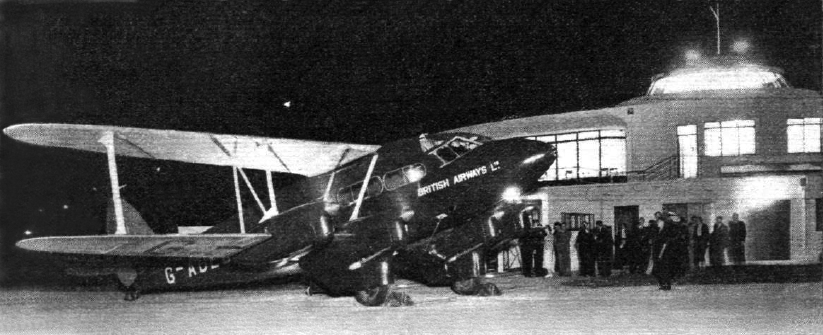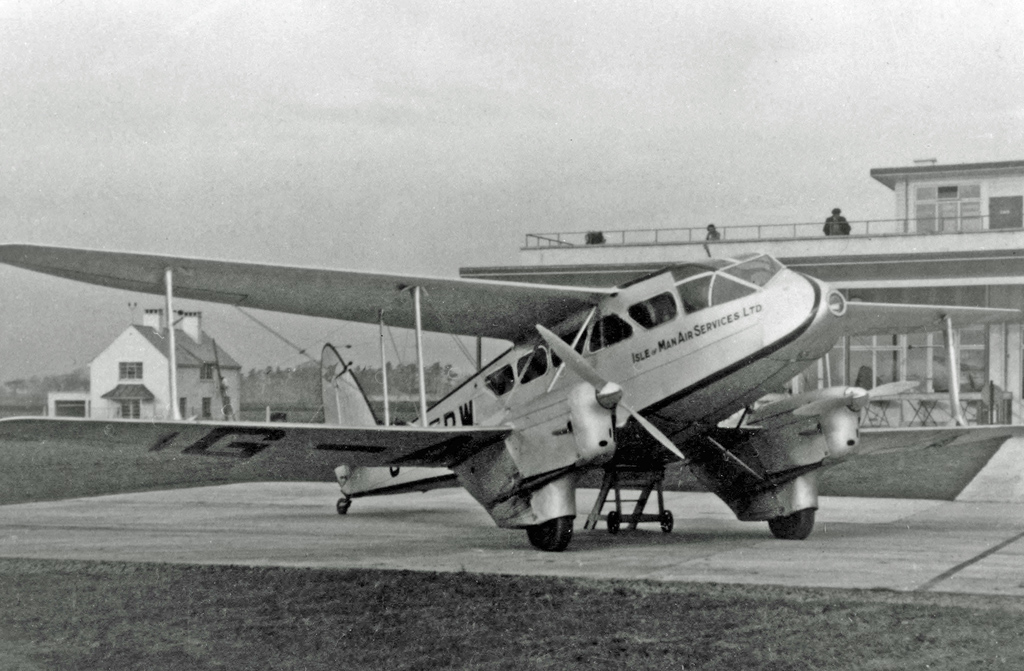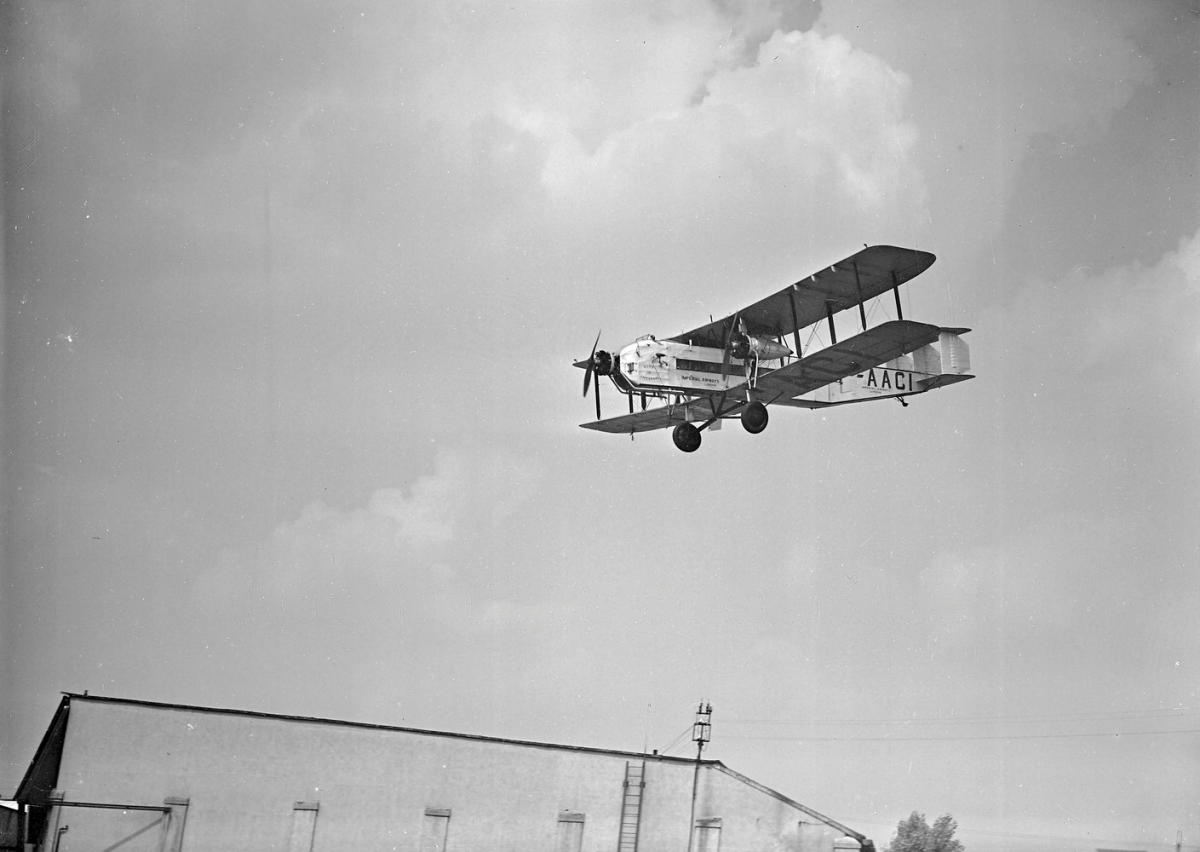|
British Airways Ltd
British Airways Ltd. was a British airline company operating in Europe in the period 1935–1939. It was formed in 1935 by the merger of Spartan Air Lines Ltd, United Airways Ltd (no relation to the US carrier United Airlines), and Hillman's Airways. Its corporate emblem was a winged lion. History On 30 September 1935, Allied British Airways Ltd was formed for the purpose of merging the publicly quoted company Hillman's Airways with the private companies of Spartan Air Lines and United Airways Ltd, both controlled by Whitehall Securities Corporation Ltd (WSC), owned by the Hon. Bernard Clive Pearson. Its directors were W. D. L. Roberts, Harold Balfour and John DeC Ballardie from WSC, plus John R. McCrindle, Edgar L. Granville and Gerard L. D'Erlanger from Hillman's. On 29 October 1935, the name was changed to British Airways Ltd, and on 11 December 1935 it converted to a public company. Whitehall Securities was joined as investor in the merged airline by banking house ... [...More Info...] [...Related Items...] OR: [Wikipedia] [Google] [Baidu] |
Public Company
A public company is a company whose ownership is organized via shares of share capital, stock which are intended to be freely traded on a stock exchange or in over-the-counter (finance), over-the-counter markets. A public (publicly traded) company can be listed on a stock exchange (listing (finance), listed company), which facilitates the trade of shares, or not (unlisted public company). In some jurisdictions, public companies over a certain size must be listed on an exchange. In most cases, public companies are ''private'' enterprises in the ''private'' sector, and "public" emphasizes their reporting and trading on the public markets. Public companies are formed within the legal systems of particular states and so have associations and formal designations, which are distinct and separate in the polity in which they reside. In the United States, for example, a public company is usually a type of corporation, though a corporation need not be a public company. In the United Kin ... [...More Info...] [...Related Items...] OR: [Wikipedia] [Google] [Baidu] |
Isle Of Man
The Isle of Man ( , also ), or Mann ( ), is a self-governing British Crown Dependency in the Irish Sea, between Great Britain and Ireland. As head of state, Charles III holds the title Lord of Mann and is represented by a Lieutenant Governor. The government of the United Kingdom is responsible for the Isle of Man's military defence and represents it abroad, but the Isle of Man still has a separate international identity. Humans have lived on the island since before 6500 BC. Gaelic cultural influence began in the 5th century AD, when Irish missionaries following the teaching of St Patrick began settling the island, and the Manx language, a branch of the Goidelic languages, emerged. In 627, King Edwin of Northumbria conquered the Isle of Man along with most of Mercia. In the 9th century, Norsemen established the thalassocratic Kingdom of the Isles, which included the Hebrides and the Northern Isles, along with the Isle of Man as the southernmost island. Magnus Bar ... [...More Info...] [...Related Items...] OR: [Wikipedia] [Google] [Baidu] |
Blackpool
Blackpool is a seaside town in Lancashire, England. It is located on the Irish Sea coast of the Fylde peninsula, approximately north of Liverpool and west of Preston, Lancashire, Preston. It is the main settlement in the Borough of Blackpool, borough of the same name. Blackpool was originally a small hamlet; it began to grow in the mid-eighteenth century, when sea bathing for health purposes became fashionable. Blackpool's beach was suitable for this activity, and by 1781 several hotels had been built. The opening of a railway station in 1846 allowed more visitors to reach the resort, which continued to grow for the remainder of the nineteenth century. In 1876, the town became a borough. Blackpool's development was closely tied to the Lancashire cotton mill, cotton-mill practice of annual factory maintenance shutdowns, known as wakes weeks, when many workers chose to visit the seaside. The town saw large growth during the late Victorian and Edwardian periods. By 1951 its popu ... [...More Info...] [...Related Items...] OR: [Wikipedia] [Google] [Baidu] |
Liverpool
Liverpool is a port City status in the United Kingdom, city and metropolitan borough in Merseyside, England. It is situated on the eastern side of the River Mersey, Mersey Estuary, near the Irish Sea, north-west of London. With a population of (in ), Liverpool is the administrative, cultural and economic centre of the Liverpool City Region, a combined authority, combined authority area with a population of over 1.5 million. Established as a borough in Lancashire in 1207, Liverpool became significant in the late 17th century when the Port of Liverpool was heavily involved in the Atlantic slave trade. The port also imported cotton for the Textile manufacture during the British Industrial Revolution, Lancashire textile mills, and became a major departure point for English and Irish emigrants to North America. Liverpool rose to global economic importance at the forefront of the Industrial Revolution in the 19th century and was home to the Liverpool and Manchester Railway, firs ... [...More Info...] [...Related Items...] OR: [Wikipedia] [Google] [Baidu] |
Spartan Cruiser
The Spartan Cruiser was a 1930s British three- engined transport monoplane for 6 to 10 passengers built by Spartan Aircraft Limited at East Cowes, Isle of Wight. It was a development of the Saro-Percival Mailplane for passenger use. Development The Saro-Percival Mailplane was a three-engined monoplane mail plane designed by Edgar Percival, and built by Saunders-Roe Limited (Saro) at Cowes in 1931, the aircraft first flying early in 1932. It was a low-winged monoplane with a wooden wing and plywood fuselage powered by three de Havilland Gipsy III engines. When Saro was financially re-organised, Percival sold his interest in the aircraft to Saro, who re-designated it as the ''Saro A.24 Mailplane''. Due to the close ties between Saro and Spartan Aircraft, the development of the aircraft was transferred to Spartan, and the aircraft was re-designated again as the ''Spartan Mailplane''.Jackson 1988, pp. 188-191. The aircraft was modified to accommodate two passenger seats. Starti ... [...More Info...] [...Related Items...] OR: [Wikipedia] [Google] [Baidu] |
De Havilland Express
The de Havilland Express, also known as the de Havilland D.H.86, was a four-engined passenger aircraft manufactured by the de Havilland Aircraft Company between 1934 and 1937. Development During 1933, talks between the governments of United Kingdom, India, British Malaya, Malaya, the Straits Settlements and Australia resulted in an agreement to establish an Empire Air Mail Service. The Australian Government called for tenders on 22 September 1933 for the Singapore-Australia legs of the route, continuing as far south as Tasmania. On the following day Qantas, anticipating success in contracting for the Singapore-Brisbane leg, placed an order with de Havilland for an as-yet non-existent aircraft to be designated the ''de Havilland 86'', the prototype to fly by the end of January 1934. This order was soon followed by one from Australian National Airways, Holyman's Airways of Launceston, Tasmania to operate the Bass Strait leg of the service. The D.H.86 was initially styled the ''E ... [...More Info...] [...Related Items...] OR: [Wikipedia] [Google] [Baidu] |
De Havilland Dragon Rapide
The de Havilland DH.89 Dragon Rapide is a 1930s short-haul biplane airliner developed and produced by British aircraft company de Havilland. Capable of accommodating 6–8 passengers, it proved an economical and durable craft, despite its outdated plywood construction. Developed during the early 1930s, the Dragon Rapide was essentially a smaller, twin-engined version of the four-engined DH.86 Express, and shared a number of common features, such as its tapered wings, streamlined fairings and Gipsy Six engines. First named the "Dragon Six", the type was marketed as "Dragon Rapide" and later simply known as the "Rapide". Upon its introduction in summer 1934, it proved to be a popular aircraft with airlines and private civil operators alike, attaining considerable foreign sales in addition to its domestic use. Upon the outbreak of the World War II, many of the civil Rapides were pressed into service with the Royal Air Force (RAF) and Royal Navy. Referred to in military service ... [...More Info...] [...Related Items...] OR: [Wikipedia] [Google] [Baidu] |
De Havilland Dragon
The de Havilland DH.84 Dragon is a successful small commercial aircraft that was designed and built by the de Havilland company. Design and construction Following the commercial success of its single-engined de Havilland Fox Moth that had first flown in March 1932, that aircraft's original commercial operator Hillman's Airways requested that a larger twin-engined version be built. The Dragon was a simple, light design with a plywood box fuselage using the same type of engine and similar outer wing sections of the earlier single-engined aircraft. It was originally designated the DH.84 "Dragon Moth" but marketed as the "Dragon". A prototype, which first flew at Stag Lane Aerodrome on 12 November 1932, and the next four aircraft were delivered to Hillman's which started a commercial service in April 1933. It could carry six passengers, each with 45 lb (20 kg) of luggage on the London-Paris route on a fuel consumption of just 13 gal (49 L) per hour. The wing pan ... [...More Info...] [...Related Items...] OR: [Wikipedia] [Google] [Baidu] |
Spartan Three Seater
The Spartan Three Seater was a British three-seat biplane touring and pleasure-flying aircraft built by Spartan Aircraft Limited. History Built as a three-seat version of the Simmonds Spartan, the Three Seater was a biplane with a spruce and plywood fuselage. Although not many aircraft were built, the Three Seater was a mainstay of the pleasure flying business in the 1930s. The wings were designed to fold back easily, in order to be stored in a shed rather than requiring a dedicated hangar. Following the first batch of aircraft, designated the Three Seater I, an improved version was built and designated as the Three Seater II. The six Three Seater IIs had improved visibility for the pilot and easier access for the passengers, and were powered by a Cirrus Hermes IV engine. One Three Seater II (registered as ZK-ARH) currently survives, owned by a private individual in New Zealand, having passed through British and Irish owners (as G-ABYN and EI-ABU) since its manufacture i ... [...More Info...] [...Related Items...] OR: [Wikipedia] [Google] [Baidu] |
Armstrong Whitworth Argosy
The Armstrong Whitworth Argosy was a three-engine biplane airliner designed and produced by the British aircraft manufacturer Armstrong Whitworth Aircraft. It was the company's first airliner. The Argosy was developed during the early-to-mid 1920s in response to a statement by Imperial Airways that new multi-engined airliners were being sought to replace its single-engined counterparts then in use. Armstrong Whitworth proposed a relatively large biplane airliner, powered by three Armstrong Siddeley Jaguar engines; its construction largely composed of plywood and fabric supported by steel tubing. Imperial Airways opted to initially order a pair of aircraft to serve its European routes, while the Air Ministry ordered a single example as well. On 16 March 1926, the first Argosy, ''G-EBLF'', performed its maiden flight. Following the delivery of the second aircraft to Imperial Airways, the Argosy performed its first passenger flight on 16 July 1926, flying from London to Paris. Us ... [...More Info...] [...Related Items...] OR: [Wikipedia] [Google] [Baidu] |








